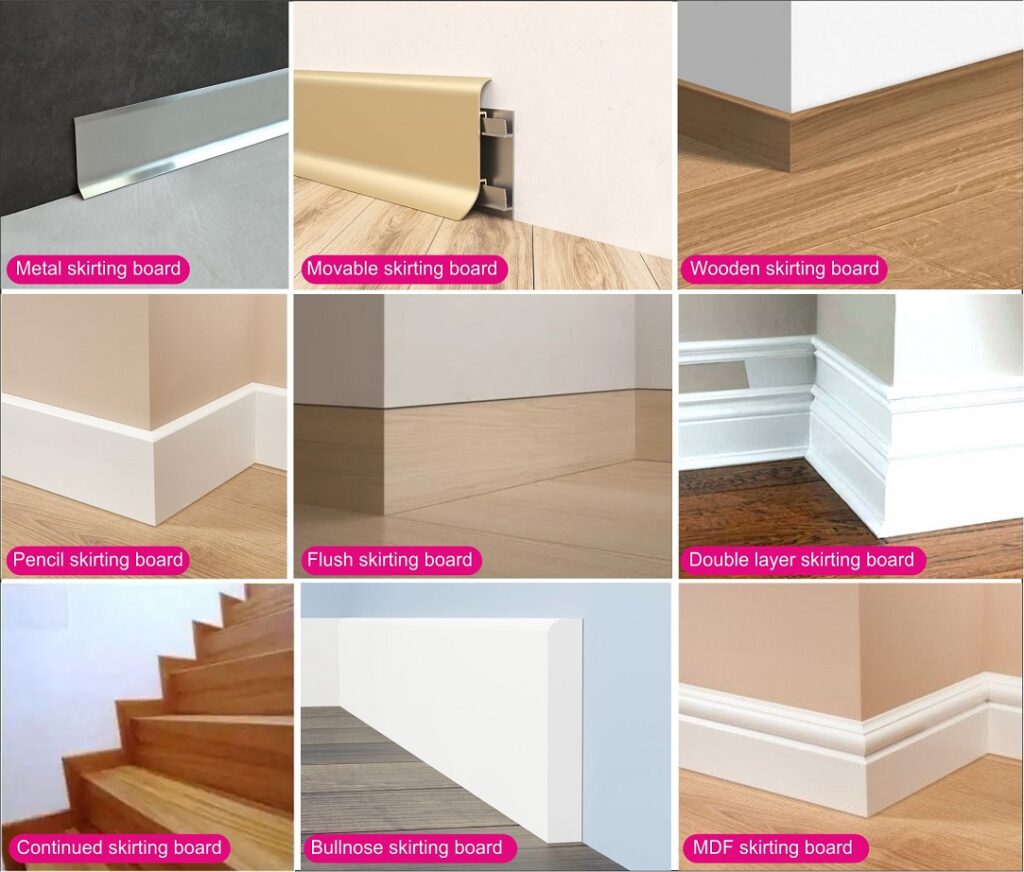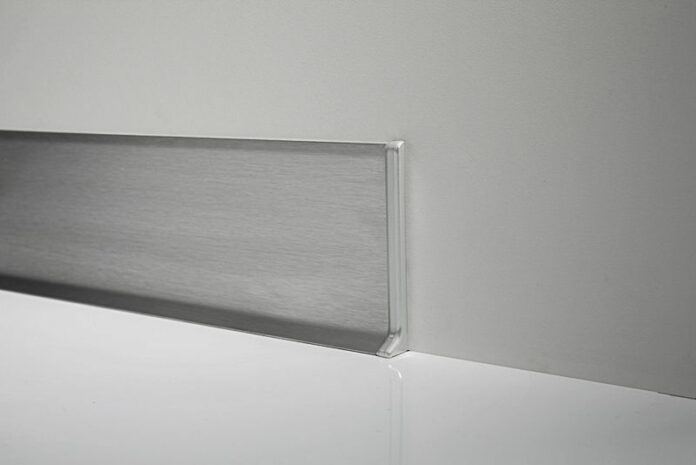Walls can be vulnerable around the base because they are exposed to various types of wear and tear. The base of the wall is often exposed to foot traffic, especially in high traffic areas such as hallways and entryways. Over time, foot traffic can cause scuff marks and other damage to the wall. Moisture can also seep into the base of the wall and cause damage over time. Skirting boards act as a barrier that prevents plaster from being cracked or broken. It is used to cover the gap between the bottom of a wall and the floor. The main function of skirting is to protect the wall from damage, such as scuffs and scratches. It also helps to provide a neat and finished appearance to a room by hiding unsightly gaps and uneven edges and reduces the risk of damage caused by machinery and equipment in industrial buildings. Skirting is installed after the wall and floor have been completed and is fixed to the wall using adhesive or screws. It can be used in commercial, industrial and residential buildings.
Skirting boards typically have the following components:
- Baseboard: The main component of a skirting board is the baseboard, which is the long, flat piece that is attached to the wall. It can be made of various materials such as wood, MDF, PVC, or metal
- Profile: The profile is the decorative molding on the front of the baseboard. The profile can vary in style, from simple designs to more ornate styles
- Top edge: The top edge of the baseboard is the edge that is flush against the wall. This edge can be flat, curved, or angled, depending on the style of the skirting board
- Bottom edge: The bottom edge of the baseboard is the edge that is flush against the floor. This edge can also be flat, curved, or angled
- Backing board: The backing board is the piece of wood that is attached to the wall before the baseboard is attached. It provides additional support for the skirting board
- Adhesive: Adhesive is used to attach the backing board and the baseboard to the wall.
- Fixings: Fixings, such as nails or screws, are used to secure the baseboard to the backing board and the wall.
Advantages of skirting boards
- Protects the bottom of the wall from damage, such as scuffs, scratches, and knocks, caused by foot traffic, furniture, and other objects
- Available in a variety of materials, styles, and colours
- Provide a more cohesive look for your home’s exterior
- Keep leaves and debris from collecting on porch steps
- Provide a barrier to help prevent drafts and noise from travelling between rooms
- Wiring and cables that run along the base of the wall in commercial buildings
- Filling gap between the floors and walls
- Protect the walls from damage caused by machinery or equipment used in industrial buildings
- Prevent heat loss by closing gaps between the wall and the floor
- Prevents dirt and dust from accumulating in the gap between the wall and the floor
Different types of skirting boards

In light of the latest contemporary building design, a variety of varieties of skirting boards, as well as styles, are now available.
Metal skirting board
Metal skirting boards are made of metal, such as aluminium, stainless steel, or brass. These types of skating boards are often used in commercial or industrial settings where durability and resistance to wear and tear are important. It is durable and can withstand heavy foot traffic. It requires very little maintenance and is easy to clean, making it a practical choice for high-traffic areas. Metal skirting is resistant to damage from impacts, scratches, and moisture, making it ideal for use in areas that are prone to damage.
Movable skirting board
Movable skirting boards are manufactured to be easily moved or removed. It is typically installed using a clip system, which allows the skirting to be easily lifted off the wall for access to cables or pipes behind it. These skirting boards can be lifted off the wall to provide easy access to cables or pipes that run behind it, which can be particularly useful in commercial or industrial buildings. Movable skirting boards can be adjusted to a custom height to accommodate different flooring types or to suit personal preferences.
Wooden skirting board
Wooden skirting is a popular choice for skirting boards due to its natural beauty and durability. They come in a variety of wood types and finishes to complement different interior design styles. These types of skirting boards can be painted, stained, or varnished to match the decor of a room.
Pencil skirting board
A pencil skirting board is narrow and usually has a flat, straight top edge. Pencil skirting is often used in contemporary and modern interior designs where a minimalist look is desired. Here are some benefits and considerations of using pencil skirting. This type of skirting board is narrower than other types of skirting boards, making it a good choice for rooms where space is limited.
Flush skirting board
Flush skirting board that is designed to sit flush with the wall, rather than protruding out from it. This type of skirting board provides a clean and seamless look to the walls, which can be very desirable in modern commercial interiors. A flush skirting board is very easy to clean, as there are no crevices or corners for dust and dirt to accumulate in.
Double layer skirting board
Double layer skirting board that has two layers. The bottom layer typically sits flush with the wall, while the top layer protrudes out from the wall and provides a decorative finish. The two layers of skirting can offer additional protection to walls and baseboards. The bottom layer of double layer skirting can be used to hide imperfections in the wall, such as gaps or unevenness.
Continued skirting board
Continued skirting boards are installed to run seamlessly along the length of a wall, without any breaks or gaps. It is also sometimes referred to as “running skirting” or “continuous skirting.” The height of this type of skirting board remains consistent along the length of the wall, which can create a sense of visual balance. It can be used to conceal cables or wires running along the bottom of the wall, providing a clean and uncluttered appearance. Continued skirting board can also be installed to follow the curve of a curved wall, providing a smooth and consistent appearance.
Bullnose skirting board
A bullnose skirting board features a rounded or curved edge, similar to the shape of a bull’s nose. This type of skirting is typically made from wood, but it can also be made from other materials such as MDF or PVC. The curved edge of the bullnose skirting board can help soften the look of a room, particularly if there are a lot of straight lines and angles in the décor.
MDF skirting board
MDF skirting board is made from medium-density fibreboard (MDF), a composite wood product made by compressing wood fibres with resin and wax. These skirting boards are available in a wide range of styles, sizes, and finishes, so it can be easily customised to suit different interior design styles.
Applications of skirting boards
- Residential buildings: homes, villas, apartments etc.
- Commercial buildings: offices, hotels, retail spaces etc
- Educational institutions: schools, universities etc
- Healthcare facilities: hospitals and clinics
- Government buildings: courthouses, municipal buildings, and other government facilities
- Industrial buildings: factories and warehouses
Conclusion
Overall, skirting boards are widely used in a variety of sectors to provide a polished and finished look as well as provide practical benefits such as protection and insulation. In an upcoming article we will analyse each type of skirting board and focus on its features and applications.



